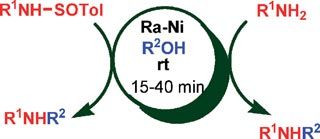Chemists grow crystals with a twist -- and untwist
Chemists from New York University and Russia's St. Petersburg State University have created crystals that can twist and untwist, pointing to a much more varied process of crystal growth than previously thought. Their work, which appears in the latest issue of the Journal of the American Chemical Society, may explain some of the properties of high-polymers, which are used in clothing and liquid crystal displays, among other consumer products.
Crystal growth has traditionally been viewed as a collection of individual atoms, molecules, or small clusters adding to a larger block that remains in a fixed translational relationship to the rest.
But the NYU and St. Petersburg State University chemists discovered a wholly new phenomenon for growth— a crystal that continually changes its shape as it grows.
To do this, the researchers focused on crystals from hippuric acid—a derivative of the amino acid glycine. As molecules were added to the end of fine crystalline needles, stresses built up at the tips of the crystals and resulted in a helical twist—much like DNA's double helix. The process was reversed when crystals thickened from the opposite end of the growing tip—that is, the crystals stiffened, thereby undoing the twisted formations. This is because the elasticity of the crystals decreases as they become thicker, thus "squeezing out" the deformations that were induced at the growing tip.
"This competition between twisting and untwisting creates needles with a rainbow of colors, which is a characteristic of tightly wound helices, as well as ribbons that have become completely untwisted," said Bart Kahr, one of the study's co-authors and a professor in NYU's Department of Chemistry, explaining the crystals' appearance. "This is a very strange and new perspective on crystal growth."
"This dynamic has not been observed before and points to a much more active process of crystal growth than we had anticipated," added Kahr, also part of NYU's Molecular Design Institute.
Most read news
Organizations
Other news from the department science
These products might interest you

Eclipse by Wyatt Technology
FFF-MALS system for separation and characterization of macromolecules and nanoparticles
The latest and most innovative FFF system designed for highest usability, robustness and data quality

Spinsolve Benchtop NMR by Magritek
Spinsolve Benchtop NMR
Spinsolve is a revolutionary multinuclear NMR spectrometer that provides the best performance

HYPERION II by Bruker
FT-IR and IR laser imaging (QCL) microscope for research and development
Analyze macroscopic samples with microscopic resolution (5 µm) in seconds

Get the chemical industry in your inbox
By submitting this form you agree that LUMITOS AG will send you the newsletter(s) selected above by email. Your data will not be passed on to third parties. Your data will be stored and processed in accordance with our data protection regulations. LUMITOS may contact you by email for the purpose of advertising or market and opinion surveys. You can revoke your consent at any time without giving reasons to LUMITOS AG, Ernst-Augustin-Str. 2, 12489 Berlin, Germany or by e-mail at revoke@lumitos.com with effect for the future. In addition, each email contains a link to unsubscribe from the corresponding newsletter.
Most read news
More news from our other portals
Last viewed contents
Serono and Evotec OAI sign assay development and screening services agreement


























































